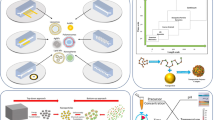Abstract
Purpose. The aim of this study was to investigate whether biodegradable nanocapsules could be obtained by the emulsification-diffusion technique.
Methods. This technique consists of emulsifying an organic solution containing an oil, a polymer, and a drug in an aqueous solution of a stabilizing agent. The subsequent addition of water to the system induces solvent diffusion into the external phase, resulting in the formation of colloidal particles. Nanoparticles obtained in this way were characterized by their particle size, zeta potential, isopycnic density and drug entrapment. The shape, surface and structure of the nanocapsules were evaluated by freeze fracture scanning electron microscopy (SEM) and by atomic force microscopy (AFM).
Results. Density gradient centrifugation confirmed the formation of nanocapsules. The density was found to be intermediate between those of nanoemulsions and nanospheres. The existence of a unique density band indicated high yields. Nanocapsule density was a function of the original oil/polymer ratio, revealing that the polymer content and, consequently, the wall thickness, can be controlled by this method. SEM and AFM showed the presence of capsular structures with smooth homogeneous walls. The versatility and effectiveness of the method were demonstrated using different lipophilic drug/oil core/wall polymer/partially water-miscible solvent systems. The mechanism of nanocapsule formation was explained as a chemical instability (diffusion stranding) generated during diffusion.
Conclusions. This study demonstrated that the emulsification-diffusion technique enables the preparation of nanocapsules in a simple, efficient, reproducible and versatile manner.
Similar content being viewed by others
REFERENCES
S. J. Douglas, S. S. Davis, and L. Illum. Nanoparticles in drug delivery. Crit. Rev. Ther. Drug Carr. Syst. 3:233–261 (1987).
J. M. Rollot, P. Couvreur, L. Roblot-Treupel, and F. Puisieux. Physicochemical and morphological characterization of polyisobutylcyanocrylate nanocapsules. J. Pharm. Sci. 75:361–364 (1986).
E. Allémann, R. Gurny, and E. Doelker. Drug-loaded nanoparticles—preparation methods and drug targetting issues. Eur. J. Pharm. Biopharm. 39:173–191 (1993).
G. Puglisi, M. Fresta, G. Giammona, and C. A. Ventura. Influence of the preparation conditions on poly(ethylcyanoacrylate) nanocapsule formation. Int. J. Pharm. 125:283–287 (1995).
N. Al Khouri-Fallouh, L. Roblot-Treupel, H. Fessi, J. P. Devissaguet, and F. Puisieux. Development of a new process for the manufacture of polyisobutylcyanocrylate nanocapsules. Int. J. Pharm. 28: 125–132 (1986).
M. Fresta, G. Cavallaro, G. Giammona, E. Wehrli, and G. Puglisi. Preparation and characterization of poly-2-cyanocrylate nanocapsules containing antiepileptic drugs. Biomaterials 17: 751–758 (1996).
J. Kreuter. Nanoparticles. In J. Kreuter (ed.), Colloidal Drug Delivery Systems, Marcel Dekker, New York, 1994, pp. 219–315.
N. Al Khouri, H. Fessi, L. Roblot-Treupel, J. P. Devissaguet, and F. Puisieux. Etude et mise au point d'un procédé original de préparation de nanocapsules de polyalkylcyanocrylate par polymérisation interfaciale. Pharm. Acta Helv. 61:274–281 (1986).
H. Fessi, F. Puisieux, J. P. Devissaguet, N. Ammoury, and S. Benita. Nanocapsule formation by interfacial polymer deposition following solvent displacement. Int. J. Pharm. 55:R1–R4 (1989).
C. Morin, G. Barrat, H. Fessi, J. P. Devissaguet, and F. Puisieux. Biodegradable nanocapsules containing a lipophilic immunomodulator: drug retention and tolerance towards macrophages in vitro. J. Drug Targeting 1:157–164 (1993).
S. S. Guterres, H. Fessi, G. Barrat, J. P. Devissaguet, and F. Puisieux. Poly(DL-lactide) nanocapsules containing diclofenac: I. Formulation and stability study. Int. J. Pharm. 113:57–63 (1995).
D. Quintanar-Guerrero, H. Fessi, E. Allémann, and E. Doelker. Influence of stabilizing agents and preparative variables on the formation of poly(D,L-lactic acid) nanoparticles by an emulsification-diffusion technique. Int. J. Pharm. 143: 133–141 (1996).
D. Quintanar-Guerrero, H. Fessi, E. Allémann, and E. Doelker. Procédé de préparation de nanocapsules de type vésiculaire, utilisables notamment comme vecteurs colloïdaux de principes actifs pharmaceutiques ou autres. French Pat. Appl. 97 09 672.
D. Quintanar-Guerrero, A. Ganem-Quintanar, H. Fessi, E. Allémann, and E. Doelker. Influence of the stabilizer coating layer on the purification and freeze-drying of poly(D,L-lactic acid) nanoparticles prepared by an emulsification-diffusion technique. J. Microencaps. 15:107–119 (1998).
M. J. Garvey, T. F. Tadros, and B. Vincent. A comparison of the adsorbed layer thickness obtained by several techniques of various molecular weight fractions of poly(vinyl alcohol) on aqueous polystyrene latex particles. J. Colloid Interface Sci. 55:440–453 (1976).
R. H. Müller, K. H. Wallis, S. D. Troster, and J. Kreuter. In vitro characterization of poly(methyl-methacrylate) nanoparticles and correlation to their in vivo fate. J. Control. Rel. 20:237–246 (1992).
F. Chouinard, S. Buczkowski, and V. Lenaerts. Poly(alkylcyanocrylate) nanocapsules: physicochemical characterization and mechanism of formation. Pharm. Res. 11:869–874 (1994).
D. Quintanar-Guerrero, E. Allémann, E. Doelker, and H. Fessi. A mechanistic study of the formation of polymer nanoparticles by the emulsification-diffusion technique. Colloid Polym. Sci. 275:640–647 (1997).
K. J. Ruschak and C. A. Miller. Spontaneous emulsification in ternary systems with mass transfer. Ind. Eng. Chem. Fundam. 11:534–540 (1972).
Author information
Authors and Affiliations
Rights and permissions
About this article
Cite this article
Quintanar-Guerrero, D., Allémann, E., Doelker, E. et al. Preparation and Characterization of Nanocapsules from Preformed Polymers by a New Process Based on Emulsification-Diffusion Technique. Pharm Res 15, 1056–1062 (1998). https://doi.org/10.1023/A:1011934328471
Issue Date:
DOI: https://doi.org/10.1023/A:1011934328471




